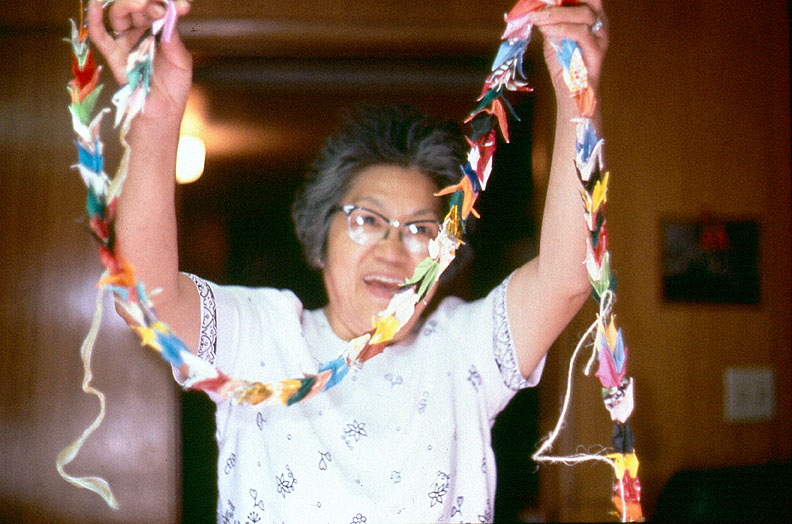- Catalog No. —
- S 1-184
- Date —
- n.d.
- Era —
- 1846-1880 (Treaties, Civil War, and Immigration), 1881-1920 (Industrialization and Progressive Reform), 1921-1949 (Great Depression and World War II), 1950-1980 (New Economy, Civil Rights, and Environmentalism), 1981-Present (Recent Oregon History)
- Themes —
- Arts, Folklife, Government, Law, and Politics
- Credits —
- Oregon Historical Society Folklife Program
- Regions —
- Portland Metropolitan
- Author —
- Suzie Jones
Japanese Oregonians and Origami
This undated photograph of an unidentified woman holding up a string of origami figures was taken by Suzie Jones.
It is not clear when origami first originated because the art of paper folding has had many names and developed independently in other countries. Most sources indicate that shortly after the development of paper—introduced in Japan in the seventh century—people began to fold it elaborately to wrap letters and gifts. Around the beginning of Japan’s Edo period (1600–1868), cranes, boats, and other shapes were being created from mass-produced inexpensive paper. The first book of Japanese origami was published in 1797.
Although Japanese immigrants settled sporadically in Oregon beginning in the 1860s, the first significant numbers arrived after 1887 when a direct steamship line was established between Portland and Kobe, Japan. The majority were young bachelors lured to the region’s economic opportunities—particularly fishing, railroad construction, and mining. The 1890 census indicates only 25 Japanese in Oregon, most living in Portland. By 1900, there were over 200 Japanese in Portland alone, many employed as domestic servants or in restaurants, boarding houses, and barbershops.
The number of Japanese families increased as Japanese women made the journey from their homeland to Oregon. The Issei (first generation) and Nisei (second generation) created lasting organizations and deep roots in their communities. By the 1940s, Portland had the seventh largest Japanese community in the nation. Despite discrimination, Japanese Oregonians became relatively prosperous and made significant contributions to their communities. Nonetheless, after the bombing of Pearl Harbor on December 7, 1941, Japanese Americans were identified as “enemy aliens.” On February 19, 1942, President Franklin D. Roosevelt signed Executive Order 9066 forcing Japanese Americans to evacuate port cities in California, Oregon, and Washington, relocating them to internment camps further inland.
Further Reading:
Chia-Chi Ho, Nelson. Portland’s Chinatown: The History of an Urban Ethnic District. Portland, Oreg., 1978.
Written by Robert Donnelly, Joshua Binus, © Oregon Historical Society, 2004, 2005.
